Structural snapshots along K48-linked ubiquitin chain formation by the HECT E3 UBR5
- PMID: 37620400
- PMCID: PMC10830417
- DOI: 10.1038/s41589-023-01414-2
Structural snapshots along K48-linked ubiquitin chain formation by the HECT E3 UBR5
Abstract
Ubiquitin (Ub) chain formation by homologous to E6AP C-terminus (HECT)-family E3 ligases regulates vast biology, yet the structural mechanisms remain unknown. We used chemistry and cryo-electron microscopy (cryo-EM) to visualize stable mimics of the intermediates along K48-linked Ub chain formation by the human E3, UBR5. The structural data reveal a ≈ 620 kDa UBR5 dimer as the functional unit, comprising a scaffold with flexibly tethered Ub-associated (UBA) domains, and elaborately arranged HECT domains. Chains are forged by a UBA domain capturing an acceptor Ub, with its K48 lured into the active site by numerous interactions between the acceptor Ub, manifold UBR5 elements and the donor Ub. The cryo-EM reconstructions allow defining conserved HECT domain conformations catalyzing Ub transfer from E2 to E3 and from E3. Our data show how a full-length E3, ubiquitins to be adjoined, E2 and intermediary products guide a feed-forward HECT domain conformational cycle establishing a highly efficient, broadly targeting, K48-linked Ub chain forging machine.
© 2023. The Author(s).
Conflict of interest statement
B.A.S. is a member of the scientific advisory boards of Interline Therapeutics and BioTheryX and co-inventor of intellectual property licensed to Cinsano. The remaining authors declare no competing interest.
Figures
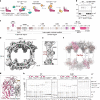



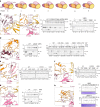
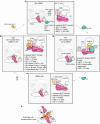
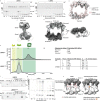

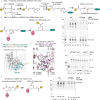


Similar articles
-
Cryo-EM structure of the chain-elongating E3 ubiquitin ligase UBR5.EMBO J. 2023 Aug 15;42(16):e113348. doi: 10.15252/embj.2022113348. Epub 2023 Jul 6. EMBO J. 2023. PMID: 37409633 Free PMC article.
-
Insights into ubiquitin transfer cascades from a structure of a UbcH5B approximately ubiquitin-HECT(NEDD4L) complex.Mol Cell. 2009 Dec 25;36(6):1095-102. doi: 10.1016/j.molcel.2009.11.010. Mol Cell. 2009. PMID: 20064473 Free PMC article.
-
Structure of UBE2K-Ub/E3/polyUb reveals mechanisms of K48-linked Ub chain extension.Nat Chem Biol. 2022 Apr;18(4):422-431. doi: 10.1038/s41589-021-00952-x. Epub 2022 Jan 13. Nat Chem Biol. 2022. PMID: 35027744 Free PMC article.
-
The exploitation of host autophagy and ubiquitin machinery by Mycobacterium tuberculosis in shaping immune responses and host defense during infection.Autophagy. 2023 Jan;19(1):3-23. doi: 10.1080/15548627.2021.2021495. Epub 2022 Jan 9. Autophagy. 2023. PMID: 35000542 Free PMC article. Review.
-
Chemical Tools for Probing the Ub/Ubl Conjugation Cascades.Chembiochem. 2025 Jan 2;26(1):e202400659. doi: 10.1002/cbic.202400659. Epub 2024 Nov 6. Chembiochem. 2025. PMID: 39313481 Free PMC article. Review.
Cited by
-
The G1/S transition is promoted by Rb degradation via the E3 ligase UBR5.bioRxiv [Preprint]. 2024 Apr 12:2023.10.03.560768. doi: 10.1101/2023.10.03.560768. bioRxiv. 2024. Update in: Sci Adv. 2024 Oct 25;10(43):eadq6858. doi: 10.1126/sciadv.adq6858. PMID: 37873473 Free PMC article. Updated. Preprint.
-
Design and Semisynthesis of Biselectrophile-Functionalized Ubiquitin Probes To Investigate Transthioesterification Reactions.Org Lett. 2024 Jun 7;26(22):4594-4599. doi: 10.1021/acs.orglett.4c01102. Epub 2024 May 23. Org Lett. 2024. PMID: 38781175 Free PMC article.
-
The G1-S transition is promoted by Rb degradation via the E3 ligase UBR5.Sci Adv. 2024 Oct 25;10(43):eadq6858. doi: 10.1126/sciadv.adq6858. Epub 2024 Oct 23. Sci Adv. 2024. PMID: 39441926 Free PMC article.
-
Understanding ubiquitination in neurodevelopment by integrating insights across space and time.Nat Struct Mol Biol. 2025 Jan;32(1):14-22. doi: 10.1038/s41594-024-01422-3. Epub 2024 Dec 4. Nat Struct Mol Biol. 2025. PMID: 39633012 Review.
-
Mechanistic insights into a heterobifunctional degrader-induced PTPN2/N1 complex.Commun Chem. 2024 Aug 16;7(1):183. doi: 10.1038/s42004-024-01263-7. Commun Chem. 2024. PMID: 39152201 Free PMC article.
References
Publication types
MeSH terms
Substances
Grants and funding
LinkOut - more resources
Full Text Sources
Molecular Biology Databases
Research Materials

